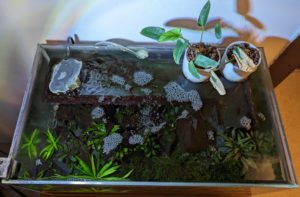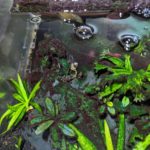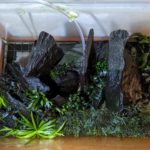Black beard algae (BBA, brush algae) used to be a bit of a nuisance in the Fireplace Aquarium, but since switching to a high phosphate, estimative index dosing regimen, BBA and really all forms of algae have been pretty much a non-issue. Tanks need to sort their own equilibrium, and what works for the high-tech CO2-injected Fireplace Aquarium is not necessarily appropriate for the low tech Shrimphaus. In general I prefer to ‘live and let live’ within reason for algae in an aquarium but in the Shrimphaus BBA has got to the point where it’s hurting the plants and not looking very pretty either.
What to do about it?
Addressing the root cause of algae – light
There is a lot of mumbo-jumbo on the internet around what causes algae but one key factor is excessive light. Usually this means light that has too high of an intensity moreso than light that is on for too much time so turning down light intensity should be job one. Shrimphaus uses a Lumini Asta 20 nano LED aquarium light on a timer which I have been running at 40% intensity for eight hours per day. Clearly that’s too much light – most of the BBA is on the left of tank where the light is, so the relationship between algae and light is pretty obvious. I have turned the lighting intensity down to 20% and we’ll how much that helps. The problem though is that even if lower intensity lighting stops most new algae growth that won’t remove the BBA already present.
Clearing existing black beard algae
Chemical control will be needed to reset the algae situation. We’re beyond the spot-treatment stage so something that can be dosed to the water column is the answer. There are a lot of recommendations for ‘liquid carbon‘ in this regard which I used to use in the Fireplace Aquarium. Whilst that’s brilliant for spot treatment I was never really convinced it was useful for algae in water column administration, and in fact I stopped using liquid carbon altogether about a year ago. There are occasional recommendations for total light blackouts which I don’t think will work, and for hydrogen peroxide which can easily go tragically wrong so I’m going to try a dedicated on-the-label algaecide.
Trying Tetra AlguMin
Tetra markets AlguMin as a fast-acting algaecide. The active ingredient is monolinuron. I posted a UKAPS query about shrimp/snail safety but no one seemed have direct experience so I dug through some of the toxicology literature on monolinuron.
The Pesticide Properties Database section on monolinuron lists the aquatic invertebrate 21 day chronic exposure toxicity NOEC – no observed effect concentration – as 0.56 mg/litre from studies in Daphnia; there is separately a listing for the 21 day chronic toxicity NOEC at 1.6 mg/L. The stock solution ‘AlguMin in the bottle’ has monolinuron at 0.245g/100 ml = 2.45 g/litre. The recommended dose is 5 ml / 10 litres water, a 2000x dilution, which would make the concentration of monolinuron in the aquarium at recommended usage 1.225 mg/litre or a little over 2x the lower three-week exposure NOEC figure. The acute toxicity for aquatic invertebrates (EC50 – 48h) is 32.5 mg/L which is more than 25x the recommended usage. More extensive data is consistent with these figures. Listed toxicity to algae varies by algae species and study, but is generally at least 5x more sensitive than aquatic invertebrates and in some studies much more sensitive than that. Tetra recommends a 2 week course at full strength, and a follow-up course(s) at half-strength (at the aquatic invertebrate NOEC) every two weeks if necessary.
Today I did an almost complete water change in the Shrimphaus, prepping up 20 litres of conditioned water with an added 10 ml of AlguMin. AlguMin is a clear, colourless, somewhat viscous, almost oily-looking liquid. It has a dosing cap on the bottle which is hard to figure out so instead I used a 10 ml syringe to be sure of using the correct amount. The AlguMin dissolved immediately and completely in the water. 18 litres of the treated water were enough to almost completely fill the Shrimphaus and ensure all the algae everwhere was fully submerged – I disposed of the remaining treated water in the back garden. The AlguMin instructions specify to be sure the aquarium water is well-oxygenated for example by using an airstone, and of course the Shrimphaus already has an airstone so no worries there.

There were no obvious adverse effects on shrimp or snails and although the snails did seem more active than usual that is also a common effect of a big water change and importantly they weren’t trying to exit the water. Twelve hours later and everything is still looking good. I did notice some juvenile shrimp in the Shrimphaus which if something goes wrong may be a sensitive indicator of toxicity problems. Of course, one hopes that with the right dose there won’t be any toxicity problems, consistent with the first rule of toxicology, “the dose makes the poison”. One immediate observational difference is that the AlguMin has changed the surface tension characteristics of the water so the airstone makes smaller more consistently sized bubbles than before. That’s not good or bad, just an observation.
More details to follow…


